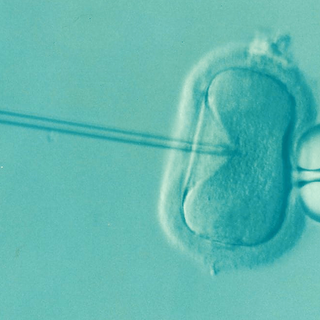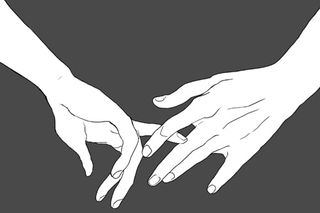
Asexuality Is a Sexual Orientation, Not A Disorder
Why would we assume sexual desire is a universal experience?

In our ever-expanding vocabulary to describe a person’s sexual orientation, asexuality is one of the more difficult terms to define. This is because asexuality encompasses a spectrum, which very much depends on the personal preference of an individual. But a loose definition of an asexual person (or ‘ace’ for short) is someone who does not experience sexual attraction.
There are several caveats to this: ace people may still engage in sex, may still get sexually aroused, may still masturbate, and may be in happy, healthy relationships. All it really means is that the person doesn’t experience the same drive or inclination to have sex that other people might. Unlike celibacy, where someone chooses not to act on their sexual desire, asexuality is not a decision, but simply another aspect of a person’s identity, just like being gay, bi, queer, or pansexual. People may realize they’re ace in the same way they discover anything else about their sexual orientation, and this might evolve over time, just as it does with other queer folks.
One of the most common assumptions about ace people is that they’re frigid, don’t desire intimacy with people, and won’t ever date, fall in love, or get married. But that conflates romantic attraction with sexual attraction — two very different things. Asexuality does not preclude romantic relationships or feelings towards someone. Many ace people experience romantic attraction and vary in how they choose to fulfill those needs. The distinction between sexual and romantic orientations has given rise to a number of helpful terms that specify both the spectrum of sexual desire that a person might experience, and other aspects of their sexual identity.
For example, on the spectrum of asexuality, a person can identify as somewhere in between allosexual (a person who experiences sexual attraction) and asexual. Gray-A and demisexual people fall in this area, where the former is a catch-all term for anyone still figuring out what works for them, and the latter is used by people who don’t experience sexual attraction until they form a close emotional relationship with the person first. Depending on what gender a person is attracted to, they can also be heteroromantic, homoromantic, biromantic, panromantic, or aromantic, i.e. people who have no desire for romantic relationships at all. Like the most inclusive buffet, a person can identify their orientations through the specifics of their sexual and gender preferences. A person could identify as demisexual panromantic or an asexual heteroromantic — it just depends on how they feel at that point in their lives.
Ace folks on the spectrum can still express love and intimacy through acts other than sex. They’re just like anyone else, and value communication, closeness, excitement, and trust in their relationships with people. Some have their emotional needs met by close friendships, while others might seek more intimate or long-term partnerships with allosexual people as well as other ace folks. And arguably, figuring out ways to be intimate outside of the practiced choreography of sex can be incredibly freeing, because it requires communicating each individual’s desires and boundaries.
Related on The Swaddle:
The Ethical Pitfalls of ‘Corrective’ Surgery for Intersex Babies
While asexuality is certainly not a new phenomenon, its recognition and classification is something that is fairly new to public discourse, and therefore, there’s a lot of misinformation and misunderstanding around it. In 1948, when Alfred Kinsey, the American sexologist and researcher, first published the Kinsey Reports that tried to classify human sexual desire from a scale that ranged from zero (exclusively heterosexual) to six (exclusively homosexual), he referred to another category that reported no sexual attraction for either gender — which he identified as ‘X.’ This is taken to be one of the first instances where a scientific study acknowledged the existence of asexual people.
While there’s still scope for more research into the area, scientists continue to disagree on the validity of the orientation. Some schools of thought have tried to classify asexuality as sexual aversion disorder, or hypoactive sexual desire disorder. In 2016, researchers at the University of British Columbia published a paper concluding that asexuality is not a psychiatric condition or a disorder, but a distinct sexual orientation. However, this continues to be a contested subject among the scientific community. As new research is undertaken to correct mistaken assumptions, ace folks themselves have been instrumental in pushing for accurate information and research resources.
The Asexuality Visibility and Education Network (AVEN), an international online community with more than 120,000 members, provides space for discussion and sharing of educational resources. Inspired by the community at AVEN, Sai Kumar and Poornima Kumar set up an India-based resource, Asexuality India, to help people who might be ace think through their identities and some of the obstacles they might face here. Even though Indians are notoriously prudish about discussing sex, the social expectations for people to get married and have children can be a problem for some ace folks. In recognition of these issues, perhaps, speed dating events,educational workshops, dating apps, and even a matrimonial match-making platforms (called ‘Platonicity’) for ace people have been launched in India.
Related on The Swaddle:
Talking With Alok Vaid‑Menon About Art, Activism, and the Transfeminine Movement
But people who identify as asexual also face a lot of discrimination, invisibility, and even violence. Short of outright denying the legitimacy of the orientation, people view asexuality as some kind of threat to our understanding of ourselves. It reflects our most basic assumptions about humans — that sex is the most natural desire and being sexually attracted to someone is a universal experience. Which leads people to assume that ace folks are somehow lacking, that they must be suffering from a disorder and ‘corrected.’
We have seen the consequences of this dangerous idea of what is natural for humans and what is unnatural; they have played out on the rest of the LGBTQ+ community for centuries. Society has ostracized and punished anyone whose orientation strays from the heteronormative. Queer and trans people have been threatened with corrective rape, vilified, imprisoned, and killed because what they desire falls outside of the supposed norm.
Asexual people are no different. Yet, they are maligned both within the queer community and by society at large. The discrimination and active erasing of ace folks’ identity leads us down a dangerous path. We still have a long way to go, to fully embracing the A in LGBTQIA, but it’s only by expanding our definitions (and vocabularies) that we can begin to truly express the spectrum of human experiences.
Nadia Nooreyezdan is The Swaddle's culture editor. Since graduating from Columbia Journalism School, she spends her time thinking about aliens, cyborgs, and social justice sci-fi. She's also working on a memoir about her family's journey from Iran to India.
Related


Global Study: Poor Diets Have Killed More People Than Smoking, High Blood Pressure
